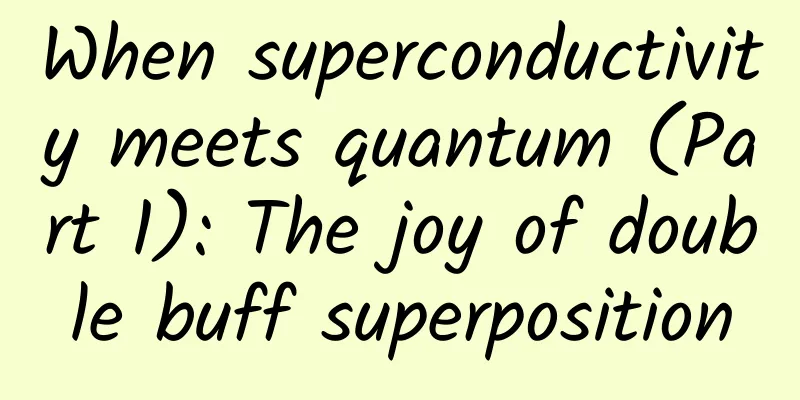When superconductivity meets quantum (Part 1): The joy of double buff superposition

|
Produced by: Science Popularization China Author: Luan Chunyang (Department of Physics, Tsinghua University) Producer: China Science Expo Recently, the field of quantum computing has achieved another milestone! The quantum artificial intelligence research team from Google used superconducting quantum computing to prove that the error rate of quantum computing can be reduced by increasing the number of quantum bits, thereby verifying the feasibility of quantum error correction. The research results were published in the world's top scientific journal Nature and attracted widespread attention from academia and industry. In 2019, the team published an extremely important paper on the cover of Nature, in which they used superconducting quantum computing to achieve "quantum supremacy" for the first time. Specifically, the team developed a quantum computer with 53 superconducting quantum bits, and successfully solved a very complex specific computing task in just 200 seconds, which would have taken about 10,000 years to complete even with the world's top supercomputer at the time, showing the huge computing potential of quantum computing. For most people, "superconductivity" and "quantum" are two words that are both familiar and unfamiliar. I believe everyone must have such doubts: what is the "superconducting quantum computing" that has surprised people again and again? What is the relationship between "superconducting quantum computing" and superconductivity? What is the relationship between it and "quantum computing"? Since quantum computers are so powerful, why do scientists still try every means to help them correct errors? Next, I will use three articles to explain these issues one by one. Superconductivity: I know you know, but don't skip it yet What is the relationship between "superconducting quantum computing" and superconductivity? This starts with the superconductivity phenomenon. Superconductivity is a very interesting and important physical phenomenon. It means that below a certain critical temperature (usually below tens of Kelvin, or around minus 200 degrees Celsius), the material can transmit electric current losslessly, thus exhibiting the characteristic of zero resistance. Traditional conductive materials, due to their resistance, will convert part of the electrical energy in the transmission line into heat energy, thus causing inevitable power loss and huge energy waste. Using superconducting materials to manufacture transmission lines can greatly reduce transmission losses and thus improve energy efficiency. superconductor (Photo source: Veer Gallery) In addition to the zero resistance characteristic, materials in the superconducting state have an even more amazing property called complete diamagnetism, also known as the Meissner effect. Specifically, when a material in a superconducting state is placed in an external magnetic field, an equal and opposite magnetic field will be generated inside the superconducting material, which will cancel out the external magnetic field, so that the total magnetic field inside the superconductor is always zero. This property makes them valuable in many applications. For example, in engineering, we use the anti-magnetism of superconductors to design magnetic levitation trains. Superconducting diamagnetism (Image source: Wikipedia) In fact, the superconductivity phenomenon has been discovered for more than a hundred years since 1911, and scientists have been exploring the wonderful physical properties of superconducting materials and their possible practical applications. Since the 1960s, with the continuous development of integrated circuit technology, scientists have also been trying to use the basic principles of quantum mechanics to construct certain specific circuits in the hope of realizing quantum computing. Quantum: Do you think the quantum you know is the real quantum? Have you ever heard of the saying "When in doubt, use quantum mechanics"? When it comes to quantum, some people think of products such as quantum cups, quantum glasses, and quantum insoles. In fact, they are not exactly the same as quantum, but have nothing to do with it. In fact, quantum mechanics is not mysterious. It is a physical theory that describes the laws of motion of tiny particles in the microscopic world. In order to give everyone a more intuitive understanding of quantum mechanics, we can split it into two words, "quantum" and "mechanics". In fact, "quantum" is not a real particle, but the smallest unit of energy. The concept has a long history. At the end of the 19th century, with the continuous advancement of physics experimental technology, scientists began to discover some microscopic phenomena that were previously difficult to observe, and these novel phenomena could not be explained by the old physical theories. In order to explain these phenomena, scientists have tried to build a new theoretical framework to describe the interaction between tiny particles in the microscopic world. In the new theoretical framework, scientists have found that the change of energy is no longer continuous, but there is always a smallest energy unit, which is called "quantum". Speaking of "mechanics", I believe everyone still remembers a sentence learned in high school physics class - force is the reason for changing the state of motion of an object. In other words, "quantum" plus "mechanics" actually describes the motion laws of tiny particles in the microscopic world. Of course, as the theoretical system continues to improve, the theory of "quantum" plus "mechanics" further covers the interaction between tiny particles and the structure of microscopic matter. According to legend, the scientist who finally combined "quantum" and "mechanics" into one and named it "quantum mechanics" was Einstein himself! Therefore, quantum mechanics is not mysterious, it's just that we live in the macroscopic world and cannot feel the changes in the microscopic world. However, concepts such as quantum superposition that appear in quantum mechanics have begun to really affect our lives. Quantum computing is a new way to achieve computing using the basic principles of quantum mechanics. Quantum computing is what we see in our daily lives, such as mobile phones, computers, and calculators. They are all classical computers that can only process 0 or 1 states, and their basic computing units are called bits. In quantum computing, information can be encoded in a superposition state of 0 and 1 for parallel computing, and this basic computing unit that can represent both 0 and 1 states is called a quantum bit (qubit). In other words, quantum computing is able to possess exponential supercomputing power precisely because of the ability of quantum bits to simultaneously encode superposition states of 0 and 1, thus being able to complete tasks faster than classical computers on certain specific computing problems. In the public's impression, "quantum" always carries a hint of mystery, because it is often associated with the latest scientific progress or science fiction works, and quantum computing represents mysterious computing speed. What kind of sparks will burst out when the superconductivity we are familiar with meets the mysterious quantum computing? Yes, it is the “superconducting quantum computing” we mentioned at the beginning of the article. Superconductivity + quantum computing = superconducting quantum computing Here we need to introduce some basic circuit knowledge to help you better understand the core concept of superconducting quantum computing. For example, if we imagine a circuit model, after the energy of the entire circuit is processed by quantum mechanics, strange phenomena will occur. The energy change of the circuit can no longer be continuous, but can only increase or decrease in a minimum energy unit. What does this mean? Just like going up and down the stairs in our daily life, before the elevator was invented, we could stay anywhere in the corridor. For example, we could stop at the 3rd or 4th floor, or stay in the stairwell between the 3rd and 4th floors. This can be regarded as a continuous change process. However, when we take the elevator, we can only stay at fixed floors, and cannot stay between the 3rd and 4th floors. This way of changing only in the smallest interval unit is the unique "discrete phenomenon" in quantum mechanics. (Photo source: Veer Gallery) That is to say, after being processed by quantum mechanics, the system energy of the circuit system can only be in certain specific states, and this energy state with discrete properties has a more vivid name - energy level. This special structure of equidistant energy levels cannot be used directly to realize quantum computing. The reason is very simple. Imagine that we only encode the two lowest energy levels of the entire circuit system as 0 and 1, and realize the transition between the two energy levels in some way. At this time, since the energy level spacing of the entire system is equal, this transition will not only occur between state 0 and state 1, but also between energy levels with higher energy. For example, transitions occur between state 1 and state 2, and between state 2 and state 3. In this way, we can only make irregular transitions between many energy levels, and cannot construct quantum bits that only encode state 0 and state 1. At this time, superconducting materials are needed. Scientists use superconducting materials to create a magical electrical structure that can artificially destroy this equal spacing of energy levels, thereby constructing quantum bits that can stably encode 0 and 1 states. Scientists have discovered that if a thin insulating layer (thickness of about 1nm) is inserted between two superconductors, thus forming a "sandwich" structure of "superconductor-insulating layer-superconductor", the energy of the circuit system will no longer change linearly. The higher the energy level, the smaller the interval between energy levels. This special sandwich structure is also called a Josephson junction. Josephson knot (Image source: drawn by the author) In this way, the superconducting circuit composed of the Josephson junction can encode the two lowest energy levels into states 0 and 1 respectively, thereby constructing a stable superconducting quantum bit. At present, there are two mainstream types of superconducting quantum bits, namely: "flux bit" and "Transmon bit". (Photo source: Veer Gallery) The "flux bit" consists of an inductor L and a Josephson junction. At this time, there can be two different current directions in the superconducting circuit, clockwise and counterclockwise, which represent different energy states of the system and can be encoded into the 0 and 1 states of the quantum bit respectively. The "Transmon bit" is composed of a capacitor element C and a Josephson junction. At this time, a wonderful phenomenon will appear in the superconducting circuit - the charge in the circuit can appear in different energy states under external regulation. Therefore, we can encode the lower energy state into the 0 state, and encode the excited higher energy state into the 1 state, thereby constructing a similar quantum bit to participate in the calculation. What is even more amazing is that when the temperature is lower than the critical temperature of the superconducting material, the electrons in the superconductors at both ends that were originally blocked by the insulating layer can actually pass through the middle insulating layer, thus establishing a nonlinear current relationship between the superconductors at both ends. Therefore, superconducting quantum computing is based on the study of superconducting phenomena and the development of quantum computing. It uses the special properties of superconducting materials to construct a nonlinear electrical element - the Josephson junction, thereby constructing superconducting quantum bits that can stably encode 0 and 1 states, and ultimately realize quantum computing with super computing power. The superconducting quantum computing solution has been widely studied by academia and industry because, on the one hand, it is compatible with today's integrated circuit technology, thus having great potential for scalability; on the other hand, superconducting quantum computing is a man-made quantum system that is highly manipulable and can meet different types of scientific research and practical needs. Therefore, superconducting quantum computing has developed rapidly and has become one of the mainstream quantum computing solutions today. Conclusion For the current mainstream quantum computer implementation scheme, superconducting quantum computing has the advantages of strong manipulability and compatibility with current integrated circuit technology. However, its own superconducting quantum bits are very susceptible to external noise interference, resulting in a series of errors. Why do quantum computers with such powerful functions still make mistakes? Stay tuned for the next article to find out. |
<<: Why are we so sure that extreme weather is caused by global warming?
>>: Is it safe to eat the Basa fish that costs only a few dollars a pack in the supermarket?
Recommend
Zoom fully switches to Oracle Cloud services? AWS says Zoom continues to use AWS services extensively
199IT News, Beijing time, April 29, according to ...
What is the situation with online defense in many universities? Why do this?
It’s settled! Graduates from many universities co...
How much does it cost to customize a large turntable mini program in Jinzhou?
There are two types of customization of Jinzhou B...
Swimming mice, bulbous-nosed fish: Scientists discover 27 new species of creatures in unexpected places
Located in northern Peru, between the Amazon rain...
New Studio - Recording, mixing, dubbing, Baidu cloud download, movie sound processing process
New Studio - Recording, Mixing and Dubbing Resour...
iPhone XS signal is worse than previous generation? We tested it to see if it works.
[[244806]] With the iPhone XS series going on sal...
The mini app can also track checked luggage, so you can finally know where your luggage is.
Every time I take a plane and wait for my luggage...
Learn character design with Hollywood animation masters 2020 [good quality]
Learn character design with Hollywood animation m...
Community operation: How to create a good community atmosphere?
Before starting the article, I would like to shar...
Chu Shijian's resume: Which aspects should we focus on when optimizing website structure?
The website structure has been optimized to make ...
Tik Tok, are they really the next operational frontier?
Since April, I have repeatedly heard that the ope...
Apple iOS 16 upgrade will abandon iPhone 6s/Plus, iPhone SE first generation
According to 9to5 Mac, with the official release ...
The 9 most effective free fission customer acquisition, retention and monetization methods in 2020!
Affected by the epidemic, many companies have tra...
Brand marketing: 15 common consumer psychology and corresponding marketing strategies
There are many kinds of consumer psychology, and ...
A complete method for event operation!
Let me talk about my views on event operations . ...









